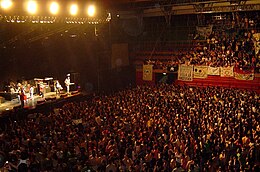Los Piojos
| Los Piojos | |
|---|---|
 |
|
| Background information | |
| Origin | El Palomar, Buenos Aires, Argentina |
| Genres | Rock, Blues, Funk, Reggae |
| Years active | 1988–2009 |
| Labels | Distribuidora Belgrano Norte, El Farolito Discos |
| Associated acts |
Patricio Rey y sus Redonditos de Ricota La Renga Charly Garcia Pappo León Gieco |
| Website | Official Website |
| Members |
Andrés Ciro Martínez Juanchi G. Bisio Miguel Ángel "Micky" Rodríguez Sebastián "Roger" Cardero Gustavo "Tavo" Kupinski † |
| Past members | Daniel Buira Daniel Fernández |
Los Piojos was an Argentine rock band. Extremely popular, it became the seminal bands of the 1990s Argentine music scene.
Unlike most suburban outfits, however, their style evolved significantly with each successive album, not only developing a unique style for the band but also incorporating elements of murga, candombe, and tango to an electric guitar base. This plus generally tight and at times memorable songwriting by frontman Ciro, has set them apart from the legions of suburban bands, and has made them one of the most popular bands in modern Argentine rock, with a strong following across Latin America and Europe, unusual for a band in their subgenre of Argentine rock. Their popularity remains undiminished.
The band's origins are traced to 1988 when a bunch of friends from different cities decided to try playing music. They began doing so in the pubs of the far-flung western suburbs of Buenos Aires, a similar beginning as countless other suburban rock bands. In 1991, they headed to Europe to participate in an anti-racist music festival in France, where they played with groups from Mali, Burkina Faso, Cuba, and Spain.
Los Piojos made their commercial debut in 1992 with Chactuchac. Receiving the very favorable blessing of Patricio Rey y sus Redonditos de Ricota, did not hurt.
Ay Ay Ay followed in 1994, and both did reasonably well. But the band could not beat back the domination by the Nuevo Rock Argentino rock ("New Argentine Rock") of the first half of the 1990s, so Los Piojos did not achieve a total breakthrough in spite that by the second album Ciro's songwriting was beginning to flourish.
The band's third studio album, Tercer Arco, benefited from the suburban rock explosion of 1996: that year alone La Renga released their seminal album Despedazado por Mil Partes, Viejas Locas released their debut with the hit single "Intoxicado", among other events that sent suburban rock to the mainstream and ended new Argentine rock's dominance. But Tercer Arco was a great album on its own right, which made the overall result all the more explosive given the reigning musical environment.
...
Wikipedia
